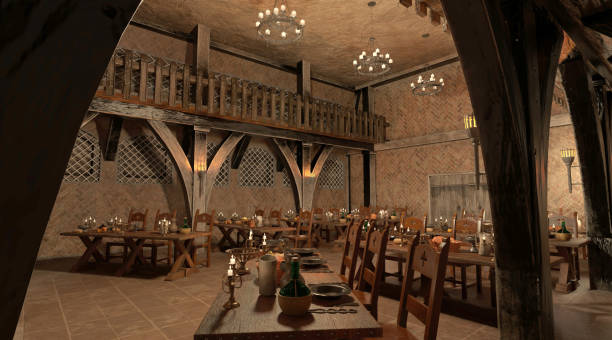Within the age of interactive eating, eateries with medieval themes have attracted foodies with immersing within the atmosphere of bygone eras. sites offer a rich, multi-sensory picture of the Renaissance, including mahogany seating, torch-lit hallways and staff costumed in historical clothing. This cuisine, however, strikes a deft balance among traditional tastes with modern food standards, even when the environment seems genuinely antique.
One of the most intriguing modern adaptations lies in the use of types of fruit sauces. These sauces — once a staple in medieval kitchens — are now creatively reimagined to suit modern palates. Fruit-based sauces, which first served to improve game meats and preserved dishes, have tastefully returned by fusing traditional inspiration with modern design and palate tastes.
Dining Like a Noble — Recreating the Medieval Experience
The wealth and formality of a noble feast are frequently imitated in restaurants with a medieval theme. Classic furnishings, wooden cutlery, and dramatic service—occasionally with live lute music or jesters—are used to welcome diners. Although the location is important, the food is what makes the vacation complete.
Foods served in the Middle Ages differed greatly according to social standing, especially among wealthier classes savoring exotic produce, spices, and elaborate preparations. Companies increasingly use improved versions of vintage foods to carry on these customs. While adhering to contemporary culinary norms, making use of berries sauces like plum or cherry reductions adds genuine taste.
Blending Historical Recipes with Modern Flavors
Historic recipes frequently presumed prior knowledge gained via employment and lacked precise measures. Modern chefs use creativity and study to reproduce these delicacies.
Signature Flavors of the Era
Historically, medieval cuisine featured:
- Meats like venison, duck, or boar
- Barley, oats, and dense breads
- Hearty vegetables and preserved fruits
- Heavy use of spice blends
- Sweet-and-savory combinations
Fruit sauces, which were acidic, spicy, and frequently served atop meat, were essential to historical taste To create healthier, more balanced meals that suit modern palates, chefs now adapt those tastes.
Modern Techniques, Historic Roots
Even though chefs today choose proteins like lamb or beef to wild game, the spirit of the past is maintained. Cooking methods like glazing of slow roast are employed, but with careful attention to control of temperature and delicate application.
Examples include:
- Duck breast in cherry-red wine reduction
- Pork loin with a spiced apple glaze
- Roasted root vegetables served with fig-balsamic drizzle
Each plate is a tribute to history — but presented with today’s refinement
Adapting for All Diets
Contemporary eaters anticipate alternatives. For this reason, eateries with medieval interiors now serve veganism and vegetarian versions of traditional dishes. The use of fruit sauces, such as cranberry-beet glaze or pear-pomegranate purée, brings food like roasted squash, lentil stew, and wheat with flowers to light.
The Role of Fruit Sauces in Culinary Storytelling
Fruit condiments are making a comeback for more reasons than just flavor; they serve as a sensory link to the past. Their richness of flavor, color, and scent contribute to the immersive experience.
: Mirroring Survival Customs
Fruit was preserved using jams, syrups, and sauces before chilling. These age-old techniques serve as inspiration for many contemporary glazes, which give each mouthful an ancestral background.
The Balance of Sweet and Savory
Medieval cuisine enjoyed combining tastes, as opposed to today’s practice of separating them. Fruity solutions provide both honey and depth, bridging the gap.
Contemporary examples include:
- Blackberry glaze on lamb
- Mango chutney over grilled chicken
- Cranberry-orange sauce paired with grain bowls
Elevating Plate Presentation
Fruits solutions provide eye candy with their vibrant hues and smooth texture in addition to their nutrition. Within a historic environment, a dish prepared with a radiant apple sauce or deep-red apple glaze instantly feels opulent and genuine.
Culinary Storytelling in Themed Dining
In medieval-themed restaurants, every meal contributes to the story. Guests aren’t just eating — they’re participating in a performance.
Menus as Part of the Fantasy
Menus are frequently based on realistic or imaginary topics. Like that, a “Knight’s Supper” may have turkey legs with cherry mustard, whilst a “King’s Hunt Feast” might include roasted meat with blackberry glaze. Here, an example of fruit sauces adds flavor to the narrative.
Seasonal Menus Inspired by Tradition
To reflect harvests and seasonal customs, many restaurants offer rotating menus. Fruit sauces help showcase the time of year:
- Spring: Rhubarb and mint glaze
- Summer: Peach-ginger drizzle
- Fall: Apple cider and clove reduction
- Winter: Cranberry and cinnamon compote
A Lasting Culinary Memory
The combination of history, taste, and storytelling leaves a strong impression. It’s not just a themed meal — it’s an experience where traditional elements like fruit sauces help tie it all together.
Conclusion
Painting the scene with armor and torchlight is only one aspect of eating with a mediaeval theme. It’s about putting history on the plate with consideration. Chefs connect millennia of food history and deliver it to contemporary audiences in a way that seems new, savory, and spectacular by judiciously utilizing common elements like spices, presentation, and particularly fruit sauces.
Such restaurants provide access to time in addition to food. Additionally, guests are certain to leave with memories as rich as the meal they ate because to be drawn to both flavor and storytelling.



